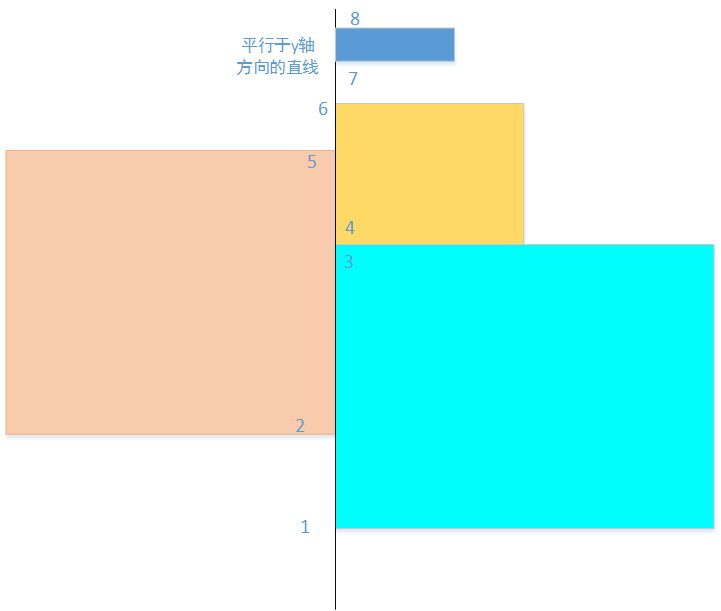poj 3168 Barn Expansion
Barn Expansion
| Time Limit: 1000MS | Memory Limit: 65536K | |
| Total Submissions: 2465 | Accepted: 666 |
Description
Farmer John has N (1 <= N <= 25,000) rectangular barns on his farm, all with sides parallel to the X and Y axes and integer corner coordinates in the range 0..1,000,000. These barns do not overlap although they may share corners and/or sides with other barns.
Since he has extra cows to milk this year, FJ would like to expand some of his barns. A barn has room to expand if it does not share a corner or a wall with any other barn. That is, FJ can expand a barn if all four of its walls can be pushed outward by at least some amount without bumping into another barn. If two barns meet at a corner, neither barn can expand.
Please determine how many barns have room to expand.
Since he has extra cows to milk this year, FJ would like to expand some of his barns. A barn has room to expand if it does not share a corner or a wall with any other barn. That is, FJ can expand a barn if all four of its walls can be pushed outward by at least some amount without bumping into another barn. If two barns meet at a corner, neither barn can expand.
Please determine how many barns have room to expand.
Input
Line 1: A single integer, N
Lines 2..N+1: Four space-separated integers A, B, C, and D, describing one barn. The lower-left corner of the barn is at (A,B) and the upper right corner is at (C,D).
Lines 2..N+1: Four space-separated integers A, B, C, and D, describing one barn. The lower-left corner of the barn is at (A,B) and the upper right corner is at (C,D).
Output
Line 1: A single integer that is the number of barns that can be expanded.
Sample Input
5 0 2 2 7 3 5 5 8 4 2 6 4 6 1 8 6 0 0 8 1
Sample Output
2
Hint
Explanation of the sample:
There are 5 barns. The first barn has its lower-left corner at (0,2) and its upper-right corner at (2,7), and so on.
Only two barns can be expanded --- the first two listed in the input. All other barns are each in contact with at least one other barn.
There are 5 barns. The first barn has its lower-left corner at (0,2) and its upper-right corner at (2,7), and so on.
Only two barns can be expanded --- the first two listed in the input. All other barns are each in contact with at least one other barn.
题意:二维坐标给定N块矩阵,如果其中某块矩阵与其他任意一块矩阵有接触的话(边或者顶点有接触),那么这块矩阵就无法扩充,问到底有多少矩阵是可以扩充的。
思路:分别用平行于y轴和x轴方向的直线扫描平面。具体做法,现在不妨用平行于y轴的直线来扫描平面,扫描到如下情况时,我们首先给所有顶点编号,不妨从下往上编,这样就得从下往上考虑,如果当前考虑到的顶点是一个矩阵一条边的起始点,那么记录器num++,
遇到的顶点是一条边的终点,num--,表示这条边不会再和接下来的矩阵存在重叠的关系。如果遇到了某个起始点,num++后num的值大于等于2,说明这个顶点左右两边的矩阵一定是有接触的(意味着一条边还没走到终点又碰到了一个起始点,那么这两条边就就有一部分重叠在了一起),例如图中,先碰到了顶点1,后来又碰到了顶点2,那么之后那部分的边就是左右矩阵所公用的。那么遇到一个终点,num--后num==0,说明这个终点之后的顶点就不能和之前的矩阵有公共边的关系了。

AC代码:
#define _CRT_SECURE_NO_DEPRECATE #include<iostream> #include<stdio.h> #include<algorithm> #include<queue> #include<set> #include<vector> #include<cstring> #include<string> #include<cmath> using namespace std; const int N_MAX =25000+ 5; int N; enum point_type{ START, END }; struct P { int x, y; int id;//坐标点是属于第几个矩形的 point_type type; P(int x,int y,int id,point_type type):x(x),y(y),id(id),type(type) {} bool operator <(const P&b)const { if (x != b.x)return x < b.x; else if (y != b.y)return y < b.y; else return type < b.type; } }; //P p1[N_MAX], p2[N_MAX]; vector<P>p1; vector<P>p2; bool ok[N_MAX]; void scan( vector<P>p1) { vector<P>::iterator it = p1.begin(); int connect_num = 0; int cur_x = it->x; bool illegal = 0; while (it!=p1.end()) { if (cur_x != it->x) {//扫描到了新的一列上 connect_num = 0; cur_x = it->x; illegal = 0; } int cur_y = it->y; while (it!=p1.end()&&cur_x==it->x&&cur_y==it->y) {//处理同一个坐标点或者同一列上的坐标点 if (illegal)ok[it->id] = true;//这个点重合了 if (it->type == START) { connect_num++; if (connect_num >= 2)illegal = true;//按y坐标向上扫描扫描到某个顶点开始有边或者点重合了,那么两边的矩阵都不能扩展了 } if (it->type == END) { connect_num--; if (connect_num == 0)illegal = false; } it++; } } } void clear() { p1.clear(); p2.clear(); } int main() { while (scanf("%d",&N)!=EOF) { for (int i = 0;i<N;i++) { int A,B,C,D; scanf("%d%d%d%d",&A,&B,&C,&D); p1.push_back(P(A, B, i, START)); p1.push_back(P(C, B, i, START)); p1.push_back(P(A,D,i,END)); p1.push_back(P(C, D, i, END)); p2.push_back(P(B,A,i,START)); p2.push_back(P(D,A,i,START)); p2.push_back(P(B,C,i,END)); p2.push_back(P(D, C, i, END)); } sort(p1.begin(), p1.end()); sort(p2.begin(),p2.end()); memset(ok, 0, sizeof(ok)); scan(p1); scan(p2); printf("%d\n", count(ok, ok + N,false)); clear(); } return 0; }



